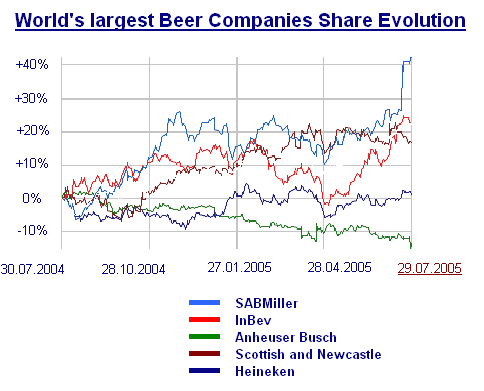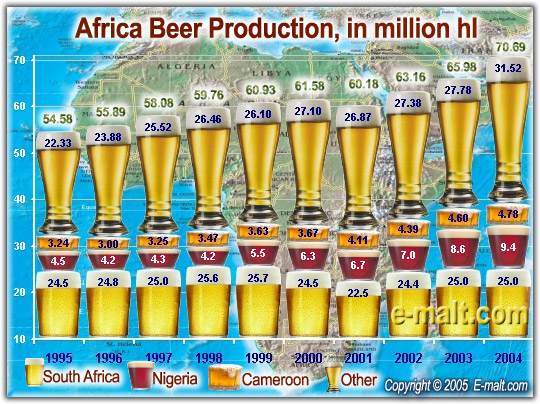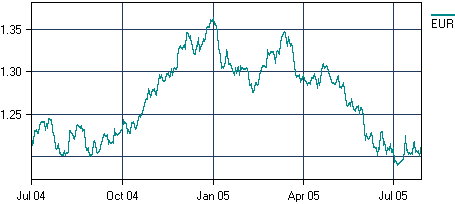 China: Carlsberg and partners inaugurate a US$ 15 mln new brewery
Carlsberg A/S announced that a new brewery – a so-called green field brewery – was inaugurated on July 29, 2005 in the Qinghai province in the Western part of China
China: Carlsberg and partners inaugurate a US$ 15 mln new brewery
Carlsberg A/S announced that a new brewery – a so-called green field brewery – was inaugurated on July 29, 2005 in the Qinghai province in the Western part of China. The brewery has an initial capacity of 0,6 million HL beer and will ultimately reach one million HL. The total investment amounts to USD 15 million.
Owners of the new brewery are Carlsberg (33,33 %) and its partners: Lanzhou Huanghe Enterprise Co. in the Gansu province (33,33 %), Qinghai Biological & Industrial Park Development & Construction Co. (16.67 %) and the Danish government via The Industrialisation Fund for Developing Countries (16.67 %).
In the Qinghai region - population around five million - the present beer-consumption is around 15 litres per capita (below national average of 22 litres per capita) and is expected to increase with the improving economy. On top of this companies in Qinghai are attracting more and more people from other provinces, which is expected to increase beer consumption.
“There is no brewery in the Qinghai province, and being the only brewery there will give the JV competitive advantages, such as lower transportation costs. And for mainstream beer generally local people prefer beer from their own province. Our JV partner Lanzhou Huanghe Enterprise Co. has already established a strong level of presence in Qinghai, estimated to have a market share of 70 %, and the new brewery will further strengthen the JV’s position in Qinghai,” CEO Michael Fredskov Christiansen, head of Carlsberg China-business, says.
...
more info
 Colombia: Grupo Empresarial Bavaria announces Q2 and H1 2005 earnings
Grupo Empresarial Bavaria (GEB), the largest beverage company in Colombia and the second-largest brewer in South America, announced on July 29 a 9.9% increase in sales volume
Colombia: Grupo Empresarial Bavaria announces Q2 and H1 2005 earnings
Grupo Empresarial Bavaria (GEB), the largest beverage company in Colombia and the second-largest brewer in South America, announced on July 29 a 9.9% increase in sales volume to 8.9 million hectoliters (hl), a 5.7% increase in net sales to Ps. 1.3 trillion, and a 12.6% increase in EBITDA to Ps. 512 billion. All comparisons are with respect to the corresponding prior-year period.
The company also announced an 8.2% increase in sales volume for the first half of 2005 as compared to the first half of 2004, reaching 17.5 million hectoliters (hl) sold. Net sales increased by 4.5% to Ps. 2.5 trillion, and EBITDA increased by 10.2% to Ps. 1.0 trillion in the first half of 2005, compared to the first half of 2004.
Ricardo Obregón, president of GEB, noted: “Record operating results during the second quarter of 2005 reflect the exceptional performance in Colombia and Peru, our two largest markets. The introduction of new packaging as part of brand re-launchings, and the introduction of new brands generated double digit growth. These results demonstrate that the commercial strategy that we are implementing is gaining ground and sets the foundation for solid future growth.”
GEB’s sales volume growth during 2Q2005 reflects the dynamism in each of its markets of operation, created by effective implementation of both price and target-consumer segmentation strategies, generating volume growth across the brand portfolio.
...
more info
 Russia: Beer consumption decreases, competition for high quality ups
Beer consumption in Russia decreased by 3.7% during the first five months of the year, according to the Federal Statistics Service
Russia: Beer consumption decreases, competition for high quality ups
Beer consumption in Russia decreased by 3.7% during the first five months of the year, according to the Federal Statistics Service and in line with market expectations, RIA Novosti communicated on July 28. Before the end of summer, another 1% is likely to be added to this figure, and by year's end annual growth of the beer sector should reach 5%. Starting next year the sector is expected to grow a healthy 3% a year.
The slowing of volume growth does not necessarily mean a slowing of income generation for the sector as consumers are expected to trade up to highly quality and more expensive brands.
Increasing disposal income and extensive advertising and promotional campaigns are likely to overcome recent advertising restrictions and public warnings about alcohol consumption.
At present, the sector is highly consolidated and dominated by large, and primarily foreign-owned, brewers. With the exception of Baltika, smaller domestic brewers are squeezed out of the market share by larger players. Under these conditions, competition should increase and put pressure on the margins of all market players.
As the sector develops, market watchers expect the larger brewers to extend market share and force the smaller producers to either fold or become niche players, RIA Novosti commented.
 USA: Anheuser-Busch reports Q2 and first six months 2005 financial results
Anheuser-Busch Cos. Inc. reported on July 27 that its consolidated net sales increased 0.2 % in the second quarter of 2005
USA: Anheuser-Busch reports Q2 and first six months 2005 financial results
Anheuser-Busch Cos. Inc. reported on July 27 that its consolidated net sales increased 0.2 % in the second quarter of 2005, while diluted earnings per share (excluding two one-time income tax gains) decreased 8.4 %. For the first six months, net sales increased 1.3 % and earnings per share (excluding one-time gains in both 2005 and 2004) declined 6.7 %.
"Anheuser-Busch had a challenging first six months in its domestic beer business,” said Patrick Stokes, president and chief executive officer of the company. “Both the company and the domestic beer industry experienced volume declines and higher cost pressures. Anheuser-Busch has implemented a number of initiatives to enhance beer volume and market share growth, including introduction of new products and packaging, increased investments in domestic marketing, stepped-up on-premise sales activities and tactical price promotions and we are encouraged by our sales improvement in June. During the second quarter, wholesaler inventories were reduced significantly and are now below last year. Although we are confident the company will restore its sales momentum and return to solid earnings growth in the future, we are currently forecasting 2005 earnings per share to be below 2004 results, excluding the one-time gains."
During the second quarter of 2005, domestic beer sales-to-wholesalers decreased 3.7 percent compared with the second quarter 2004, and wholesaler sales-to-retailers declined 0.2 percent. Wholesaler inventories were reduced significantly during the quarter, from approximately 1.5 days higher than last year at the beginning of the quarter to over one day lower than 2004 at the end of the quarter.
...
more info
 Germany: Sales of beer up 0.3% in the first half of 2005
In the first half of this year the beer producing and storing establishments in Germany sold 51.9 million hl of beer
Germany: Sales of beer up 0.3% in the first half of 2005
In the first half of this year the beer producing and storing establishments in Germany sold 51.9 million hl of beer, the Federal Statistical Office communicated on July 28. That was a increase of 0.2 million hl (+0.3%) from the corresponding period of the previous year. The rise was credited largely to increased exports to other European countries and rising sales of new mixed-drink beverages, according to analysts.
Exports to other EU countries rose by 7.3% in H1 2005, while sales of mixed drinks combining beer with juices or other soft drinks increased by 19.3%. Exports to countries outside the EU, however, declined by 5.8%, while domestic sales fell by 0.3%.
As reported by the Federal Statistical Office, the beer producing and storing establishments in Germany sold 21.9 million hl of beer in the first quarter of 2005. That was a decrease of 0.8 million hl (–3.5%) from the corresponding period of the previous year.
In 2004, the beer producing and storing establishments in Germany sold 105.8 million hl of beer. That was an increase of 0.2 million hl (+0.2%) from the previous year, according to the Federal Statistical Office. The slight growth was attributable to the increased amount of beer exported into other EU Member States, while domestic sales declined.
 Malt News
Malt News 
 Russia & Ukraine: EBRD to buy shares in Lesaffre’s yeast and malt making subsidiaries
The European Bank for Reconstruction and Development (EBRD) announced on July 28 it has signed a share purchase agreement to acquire equity stakes worth a total of up to $30 million
Russia & Ukraine: EBRD to buy shares in Lesaffre’s yeast and malt making subsidiaries
The European Bank for Reconstruction and Development (EBRD) announced on July 28 it has signed a share purchase agreement to acquire equity stakes worth a total of up to $30 million over time in certain Russian and Ukrainian subsidiaries of France’s Lesaffre & Cie SA, the world’s leading producer of yeast and the fifth largest producer of malt.
This will include minority shareholdings in the Russian yeast-making companies OOO SAF Neva and OAO Kurgandroji and the Ukrainian yeast-making company ZAT Nadezhda. The Russian and Ukrainian plants are between 40 and 100 years old and have suffered from underinvestment. Cooperation with Lesaffre, the world’s market and technology leader in the yeast segment, will enable the EBRD to participate in modernising, restructuring and upgrading them to improve quality and environmental standards and allow further development.
At the signing ceremony in London, Mr. Lucien Lesaffre, Chairman of Lesaffre & Cie S.A., said that the equity financing from the EBRD will take part in the company’s achieving their strategy to become one of the largest producers of yeast in CIS markets. He added he greatly values the Bank’s partnership as it offers Lesaffre comfort when operating in CIS markets. He believes this partnership may lead to further cooperation in the future in other countries of operations of the Bank enabling Lesaffre to produce yeast locally.
The EBRD is one of the largest private sector investors in Russia and Ukraine. Speaking at the signing ceremony in London, Mr. Jean Lemierre, President of the EBRD, said that the project is part of the Bank’s ongoing commitment to the region. In the agribusiness sector, the EBRD has signed projects worth a total of around €1.5 billion, and the Bank plans to commit €400 million this year in the sector. Mr. Lemierre added that this transaction offers an important demonstration effect for investments in agricultural processing in terms of both quality and technology.
 Barley News
Barley News 
 Australia: Demand from China for malting barley is to return to normal levels
Barley producers may receive significantly higher prices for their next crop, as worldwide demand increases and supplies from other countries fall
Australia: Demand from China for malting barley is to return to normal levels
Barley producers may receive significantly higher prices for their next crop, as worldwide demand increases and supplies from other countries fall, ABC Rural News posted on July 28. Inclement weather conditions in the northern hemisphere have seen crop estimates scaled back in both Europe and Canada.
And Nigel Officer from ABB Grain says demand from China for malting barley is expected to return to normal levels after a few years of using cheaper grain in beer production. "We would expect that China will once again import something in the order of about 2 million tonnes, maybe just a little bit over 2 million tonnes of malting barley next year," he said. "And from Australia we would expect to be supplying somewhere around about 1.5 to 1.7 million tonnes of that."
ABB Grain has again lifted pool returns to growers by a further A$5 a tonne for malting barley to between A$220 and A$230.
Meanwhile, WA's Grain Licensing Authority has approved another three special export licences. The approvals include 110,000 tonnes of feed barley to the Middle East and 60,000 tonnes of malting barley to China.
 Hops News
Hops News 
 USA: Minor acreage increase in 2005 hops crop
The official hop acreage survey conducted by the USDA has already been published. The US growers who used to play a leading role with regard to acreage reductions in former years
USA: Minor acreage increase in 2005 hops crop
The official hop acreage survey conducted by the USDA has already been published. The US growers who used to play a leading role with regard to acreage reductions in former years have increased their acreage by 586 ha (1,448 acres) in crop 2005, Joh. Barth & Sohn GmbH & Co. KG, the agricultural company that processes and trades hops and hop products worldwide, announced at the beginning of July 2005. This number is composed of 430 ha (1,062 acres) bitter hops (Galena, Super High Alpha, Nugget) and 156 ha (385 acres) aroma hops. The aroma sector also shows clear variety changes: Willamette +255 ha (+630 acres / +11%); Cascade -107 ha (-264 acres / -18%); US-Perle -82 ha (-203 acres / -67%).
The dollar which is still undervalued will help US high alpha hops in crop 2005 to regain more importance on the world market.
The big surplus of bitter hops from former crops that influenced the price structure for US spot hops has mainly been sold. Therefore the price for bitter hops crop 2005 has already recovered. Furthermore, new markets have opened up for hops outside the brewing industry. Their needs are mainly satisfied by US hops and will have growing influence on demand.
Some varieties already show a shortage in supply at present. E.g. the varieties Galena and Nugget have been completely sold by pre-contracts. The variety Millennium, however, is available to balance Nugget shortage. The variety Cluster has become a niche variety and can only be secured by making pre-contracts.
Some growers intended to introduce a Hop Marketing Order in the US. After longer hearings, this petition was finally declined by the USDA.















 Currency Rates
Currency Rates 

 Top Industry News
Top Industry News 
 More News
More News 
 Brewery News
Brewery News 









 China: Carlsberg and partners inaugurate a US$ 15 mln new brewery
...
China: Carlsberg and partners inaugurate a US$ 15 mln new brewery
...
 Russia & Ukraine: EBRD to buy shares in Lesaffre’s yeast-making subsidiaries
Russia & Ukraine: EBRD to buy shares in Lesaffre’s yeast-making subsidiaries
 Australia: Demand from China for malting barley is to return to normal levels
...
Australia: Demand from China for malting barley is to return to normal levels
...
 Australia: Fat Prophets rates ABB Grain A Buy
...
Australia: Fat Prophets rates ABB Grain A Buy
... Malt News
Malt News 